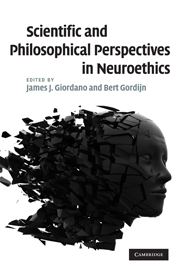Book contents
- Frontmatter
- Contents
- List of contributors
- Preface
- Acknowledgments
- Introduction
- 1 Developments in neuroscience
- 2 The origins of the modern concept of “neuroscience”
- 3 On the cusp
- 4 The mind-body issue
- 5 Personal identity and the nature of the self
- 6 Religious issues and the question of moral autonomy
- 7 Toward a cognitive neurobiology of the moral virtues
- 8 From a neurophilosophy of pain to a neuroethics of pain care
- 9 Transplantation and xenotransplantation
- 10 Neurogenetics and ethics
- 11 Neuroimaging
- 12 Can we read minds?
- 13 Possibilities, limits, and implications of brain-computer interfacing technologies
- 14 Neural engineering
- 15 Neurotechnology as a public good
- 16 Globalization: pluralist concerns and contexts
- 17 The human condition and strivings to flourish
- 18 The limits of neuro-talk
- Afterword
- Index
8 - From a neurophilosophy of pain to a neuroethics of pain care
Published online by Cambridge University Press: 07 May 2010
- Frontmatter
- Contents
- List of contributors
- Preface
- Acknowledgments
- Introduction
- 1 Developments in neuroscience
- 2 The origins of the modern concept of “neuroscience”
- 3 On the cusp
- 4 The mind-body issue
- 5 Personal identity and the nature of the self
- 6 Religious issues and the question of moral autonomy
- 7 Toward a cognitive neurobiology of the moral virtues
- 8 From a neurophilosophy of pain to a neuroethics of pain care
- 9 Transplantation and xenotransplantation
- 10 Neurogenetics and ethics
- 11 Neuroimaging
- 12 Can we read minds?
- 13 Possibilities, limits, and implications of brain-computer interfacing technologies
- 14 Neural engineering
- 15 Neurotechnology as a public good
- 16 Globalization: pluralist concerns and contexts
- 17 The human condition and strivings to flourish
- 18 The limits of neuro-talk
- Afterword
- Index
Summary
Every sentient being knows what is meant by pain, but the true significance of pain eludes the most sapient. For philosophers, pain is a problem of metaphysics … for clinicians a symptom to be understood and an ill to be relieved.
C. F. Illingworth (1941)THE NEUROSCIENCE AND NEUROPHENOMENOLOGY OF PAIN
The problem of pain
If the profession and practices of pain therapeutics are to be focally dedicated to right and good care of those in pain, then it is imperative to (1) pursue knowledge of the mechanisms and effects of the disorder that has rendered them to be patients, and (2) recognize and acknowledge that the uniqueness of pain as sensation and experience is inextricably bound to these neural event(s) (Giordano 2006). In this chapter I argue that these facts establish the progressive epistemological basis for a neurophilosophy of pain that both informs and sustains the direction for ongoing research, and gives rise to a neuroethics of pain care.
Some forty-seven years ago, British scientist and novelist C. P. Snow described what he believed was a deeply entrenched, widening rift between the “two cultures” of modern society: the sciences and the humanities (Snow 1959). Yet, one of the most significant accomplishments of contemporary neuroscience has been to make ardent strides toward what biologist E.O. Wilson calls consilience: “… a jumping together of knowledge by the linking of facts and fact-based theory across disciplines to create a common groundwork for explanation”.
- Type
- Chapter
- Information
- Scientific and Philosophical Perspectives in Neuroethics , pp. 172 - 189Publisher: Cambridge University PressPrint publication year: 2010



